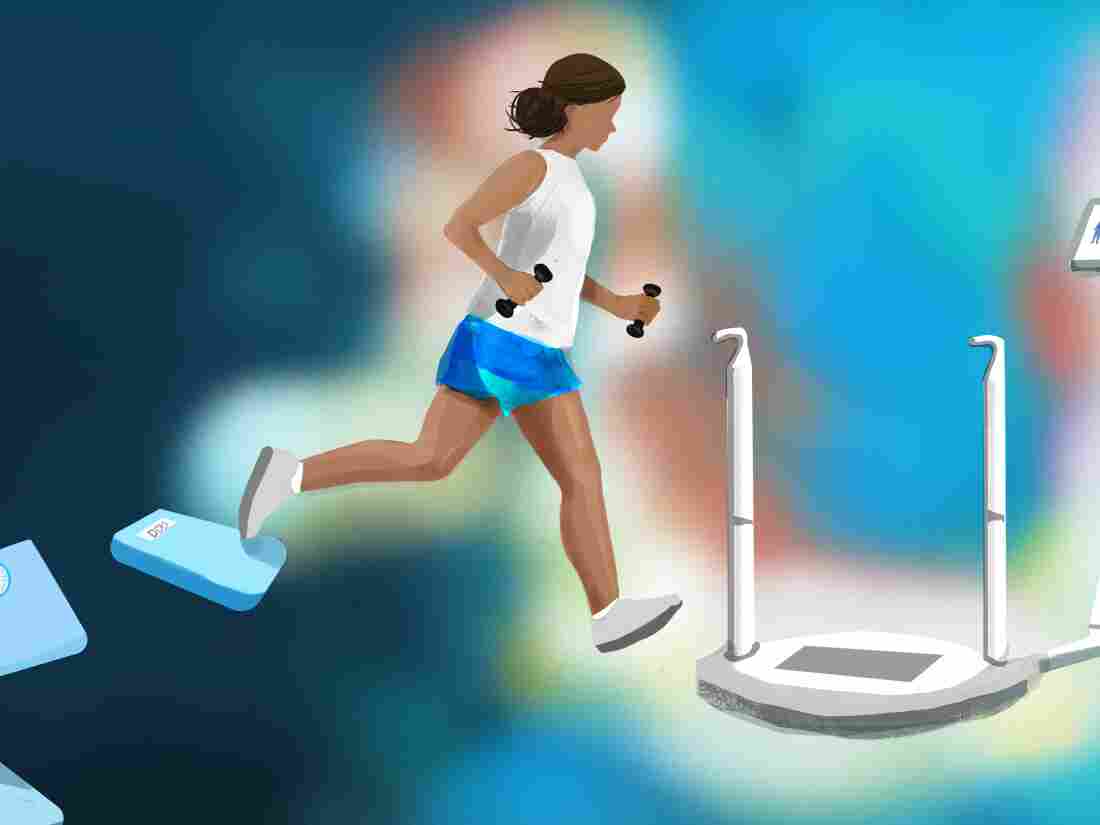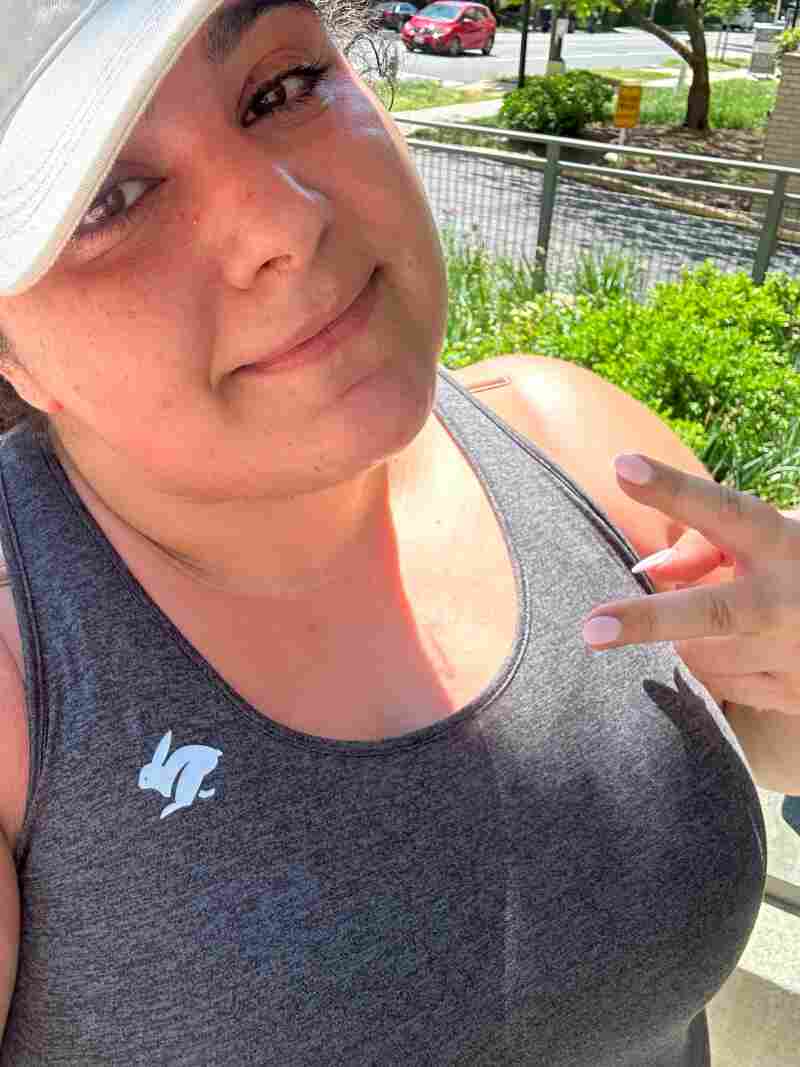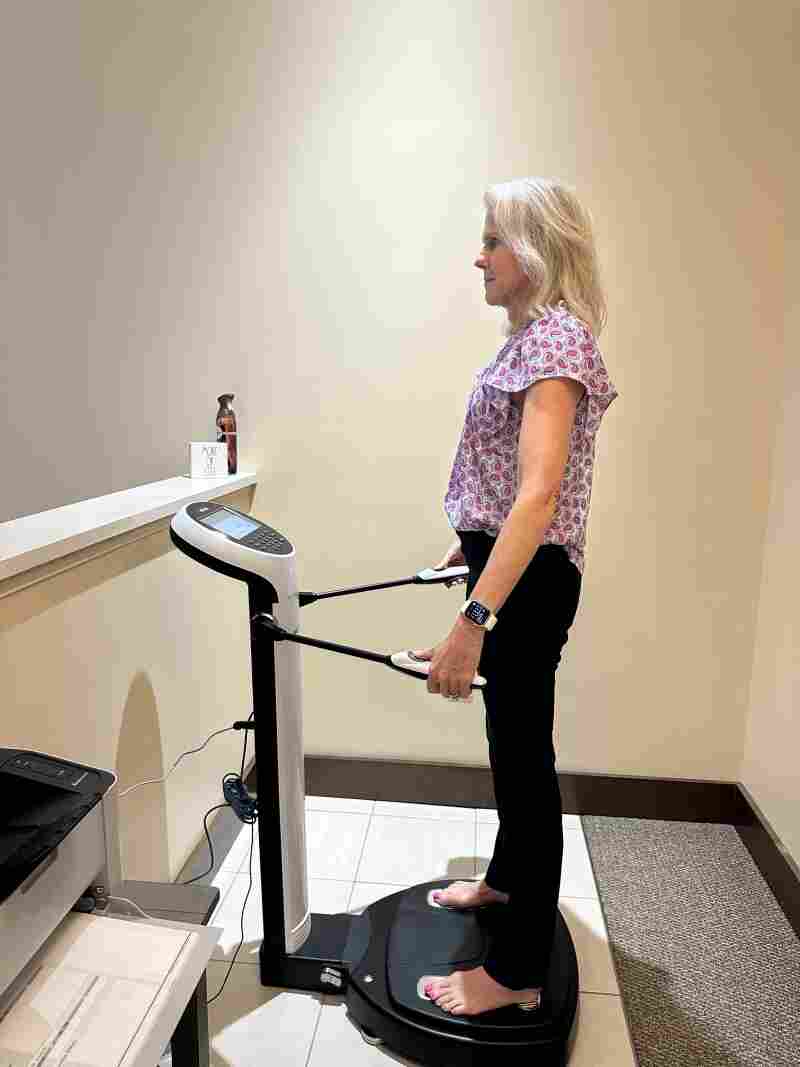
Marie Fabrizio
hide caption
toggle caption
Marie Fabrizio
The scale has never been Mana Mostatabi’s friend. Even in high school, when she ran 100 meters fast on the varsity track team, her BMI – a ratio of weight to height – placed her in the overweight category.
“My dad always joked that I should be a wrestler,” Mostatabi says of her build. Many professional athletes fail BMI tests. Some are considered obese despite being physically fit, and many doctors say that’s not a useful indicator to focus on.
“BMI is a very crude measurement,” says Dr. Richard Joseph, a physician at Brigham and Women’s Hospital who specializes in metabolic health. “That doesn’t tell me much about your underlying health,” he says. People may be of normal weight but have low muscle mass and high body fat, while others are of higher weight but are muscular and lean.
That’s why Mostatabi found a new tool – a body composition scan – that measures one’s body fat and muscle mass, which are two key indicators of one’s health. “It’s very affirmative,” says Mostatabi. Over the past year, she lost ten pounds of body fat and also gained several pounds of muscle. “It actually gives me information” to track progress. “It’s really motivating,” she says.
Body composition scans are becoming an increasingly popular way to assess health and there are many different types.
MRI (magnetic resonance imaging) is considered the gold standard, but it is not practical for most people due to cost and access to medical imaging.
Dr. Joseph orders DEXA – dual-energy x-ray absorptiometry – scans for some of his patients. These scans measure bone mineral density, as well as body composition and fat distribution. They typically cost more than $100, but prices have started to drop in some areas as demand increases and more machines become available.
One option that has taken off in gyms and workout studios, like Anytime Fitness and Orangetheory Fitness, is bioelectrical impedance analysis, using devices like the InBody or Evolt 360. According to the studio, analyzes are often free with subscription or are available for a small fee. This test is not as accurate as an MRI or DEXA, but it is reliable for tracking changes over time, as long as people follow the instructions.

Mana Mostatabi uses a body composition test to track her fitness. This helped her reduce her body fat and increase her muscle mass.
Mana Mostatabi
hide caption
toggle caption
Mana Mostatabi
Mostatabi had her first InBody scan in January, when she signed up for a strength challenge at Orangetheory. “It’s an extremely simple process,” says Mostatabi, which takes less than a minute.
The device looks like a two-arm scale. “You stand on the machine,” which has a metal base, she explains, and hold the ends of the two arms that send a safe, low-level electrical current through the body, estimating fat and lean mass.
“The speed at which this current returns to the electrodes gives a measure of how much fat and muscle mass you have, because the current passes through these body tissues at different speeds,” explains Scott Brown, vice president of fitness at Orangetheory. . This technology is decades old and has become increasingly popular with the advent of commercial devices and growing demand.
Mostatabi says you don’t feel anything during the test and the results are sent directly to a smartphone app. His first scan gave him a baseline to improve on.
She says her fitness took a nosedive during the pandemic and she was aiming for a fresh start this year. All winter, she took 60-minute classes combining resistance training, strength training, treadmill cardio and rowing. “I was very diligent,” with an average of five to six classes per week.

“The InBody analysis is the first tool I’ve used that shows gains,” she says. Mostatabi used to weigh himself and remembers his frustration when the scales wouldn’t move. Today, although she hasn’t lost weight, she knows her body is healthier, with a lower body fat percentage and increased muscle mass.
“It’s just incredibly empowering,” she says, knowing that women who train with weights and build strength can expect to live longer, healthier lives.
On average, women gain less muscle, but at a slower rate than men. During Orangetheory’s eight-week “transformation challenge,” the company found that men who focused on muscle gains added about 0.83 pounds of muscle over eight weeks, on average, compared to half a pound of muscle gain for women. However, across all participants, there was only about 0.1 lb of average muscle gain.
Eight weeks isn’t a lot of time to put on muscle, says Brown. And he says it’s important to set “realistic goals and targets,” given the variability from person to person. The ability to grow new muscles is influenced by gender, age and genetics.
Dr. Joseph explains that knowing your muscle mass can be helpful because studies show that strength is an indicator of longevity. Additionally, muscle loss increases the risk of falls, which is a leading cause of death from injury in older adults. “A lot of people are undermuscled,” Joseph says.
When it comes to body fat, having too much of it can increase the risk of metabolic disease, especially visceral fat, which surrounds the abdominal organs including the stomach, liver and intestines. “It’s inflammatory,” Joseph says, and it increases the risk of heart disease. The American College of Sport Medicine defines fitness categories for body fat based on age and gender, but there is no agreed-upon goal for what is considered ideal. Using ACSM standards, most Americans could be classified as “poor fitness”, since the average body fat among adults in the United States is 33%. The U.S. military considers optimal body fat for military fitness to be between 10 and 20 percent for young men and up to 25 percent for middle-aged men. Women generally have more body fat, with an ideal range of 15% to 30% for young women and up to 38% for middle-aged women.

Joseph says the general rule of fitness is “it’s you against you.” Rather than focusing on an external reference point, “it’s more important to look at trends over time” when it comes to your body composition, he says.
It is possible to lose fat and gain muscle without losing weight. This is what happened to Karen White, 59, and certified health coach in Alexandria, Virginia. She has gained about three pounds of muscle over the past three years and has also lost body fat. His body fat went from 26% to 22%. “Literally, I’m the exact same weight” after three years of follow-up, but the positive changes in her body composition are profound.

Karen White is a certified health coach in Alexandria, Virginia. She credits body composition testing with helping her reduce body fat and build muscle.
Jackie Cooke
hide caption
toggle caption
Jackie Cooke
She lifts weights three times a week, for about 30 minutes and gradually started lifting heavier weights. She still does cardio exercises and stays active by walking her dog daily, although she has focused on resistance training.
“There is a misconception that older people cannot gain muscle, which is absolutely false,” she says. She points to a new client she is working with who is in his sixties. Already, after a few months, her client lost body fat and increased her strength.
White agrees that it’s important to set realistic expectations and recognize that changes in body composition can take time. She gained about a pound of muscle per year on average and feels much stronger.
Since muscle mass peaks in your 30s, strength training is important to maintain muscle mass, especially as you age. “The risk of frailty increases exponentially with age,” explains Dr. Joseph. Muscle loss, also called sarcopenia, affects about 45% of older adults, especially women. Strength training can help counteract this loss.
Find Allison Aubrey on Instagram at @allison.aubrey and on @AubreyNPR.
This story was edited by Jane Greenhalgh